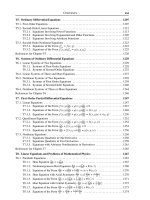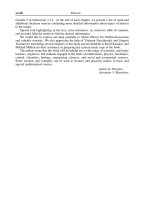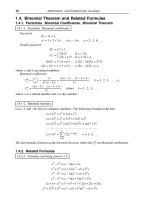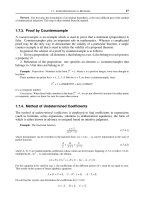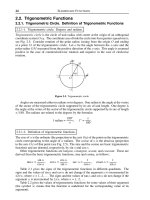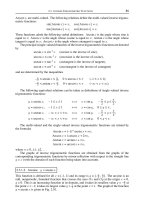Handbook of mathematics for engineers and scienteists part 6 ppsx
Bạn đang xem bản rút gọn của tài liệu. Xem và tải ngay bản đầy đủ của tài liệu tại đây (399.82 KB, 7 trang )
Chapter 1
Arithmetic and Elementary Algebra
1.1. Real Numbers
1.1.1. Integer Numbers
1.1.1-1. Natural, integer, even, and odd numbers.
Natural numbers: 1, 2, 3, (all positive whole numbers).
Integer numbers (or simply integers): 0, 1, 2, 3,
Even numbers: 0, 2, 4, (all nonnegative integers that can be divided evenly by 2).
An even number can generally be represented as n = 2k,wherek = 0, 1, 2,
Remark 1. Sometimes all integers that are multiples of 2, such as 0, 2, 4, , are considered to be
even numbers.
Odd numbers: 1, 3, 5, (all natural numbers that cannot be divided evenly by 2). An
odd number can generally be represented as n = 2k + 1,wherek = 0, 1, 2,
Remark 2. Sometimes all integers that are not multiples of 2, such as 1, 3, 5, , are considered to
be odd numbers.
All integers as well as even numbers and odd numbers form infinite countable sets,
which means that the elements of these sets can be enumerated using the natural numbers
1, 2, 3,
1.1.1-2. Prime and composite numbers.
A prime number is a positive integer that is greater than 1 and has no positive integer
divisors other than 1 and itself. The prime numbers form an infinite countable set. The first
ten prime numbers are: 2, 3, 5, 7, 11, 13, 17, 19, 23, 29,
A composite number is a positive integer that is greater than 1 and is not prime, i.e.,
has factors other than 1 and itself. Any composite number can be uniquely factored into
a product of prime numbers. The following numbers are composite: 4 = 2×2, 6 = 2×3,
8 = 2
3
, 9 = 3
2
, 10 = 2×5, 12 = 2
2
×3,
The number 1 is a special case that is considered to be neither composite nor prime.
1.1.1-3. Divisibility tests.
Below are some simple rules helping to determine if an integer is divisible by another
integer.
All integers are divisible by 1.
Divisibility by 2: last digit is divisible by 2.
Divisibility by 3: sum of digits is divisible by 3.
Divisibility by 4: two last digits form a number divisible by 4.
Divisibility by 5: last digit is either 0 or 5.
3
4 ARITHMETIC AND ELEMENTARY ALGEBRA
Divisibility by 6: divisible by both 2 and 3.
Divisibility by 9: sum of digits is divisible by 9.
Divisibility by 10: last digit is 0.
Divisibility by 11: the difference between the sum of the odd numbered digits (1st, 3rd,
5th, etc.) and the sum of the even numbered digits (2nd, 4th, etc.) is divisible by 11.
Example 1. Let us show that the number 80729 is divisible by 11.
The sum of the odd numbered digits is Σ
1
= 8 + 7 + 9 = 24. The sum of the even numbered digits is
Σ
2
= 0 + 2 = 2. The difference between them is Σ
1
– Σ
2
= 22 and is divisible by 11. Consequently, the original
number is also divisible by 11.
1.1.1-4. Greatest common divisor and least common multiple.
1
◦
.Thegreatest common divisor of natural numbers a
1
, a
2
, , a
n
is the largest natural
number, b, which is a common divisor to a
1
, , a
n
.
Suppose some positive numbers a
1
, a
2
, , a
n
are factored into products of primes so
that
a
1
= p
k
11
1
p
k
12
2
p
k
1m
m
, a
2
= p
k
21
1
p
k
22
2
p
k
2m
m
, , a
n
= p
k
n1
1
p
k
n2
2
p
k
nm
m
,
where p
1
, p
2
, , p
n
are different prime numbers, the k
ij
are positive integers (i = 1, 2,
, n; j = 1, 2, , m). Then the greatest common divisor b of a
1
, a
2
, , a
n
is calculated
as
b = p
σ
1
1
p
σ
2
2
p
σ
m
m
, σ
j
=min
1≤i≤n
k
ij
.
Example 2. The greatest common divisor of 180 and 280 is 2
2
×5= 20 due to the following factorization:
180 = 2
2
×3
2
×5 = 2
2
×3
2
×5
1
×7
0
,
280 = 2
3
×5×7 = 2
3
×3
0
×5
1
×7
1
.
2
◦
.Theleast common multiple of n natural numbers a
1
, a
2
, , a
n
is the smallest natural
number, A, that is a multiple of all the a
k
.
Suppose some natural numbers a
1
, , a
n
are factored into products of primes just as
in Item 1
◦
. Then the least common multiple of all the a
k
is calculated as
A = p
ν
1
1
p
ν
2
2
p
ν
m
m
, ν
j
=max
1≤i≤n
k
ij
.
Example 3. The least common multiple of 180 and 280 is equal to 2
3
×3
2
×5
1
×7
1
= 2520 due to their
factorization given in Example 2.
1.1.2. Real, Rational, and Irrational Numbers
1.1.2-1. Real numbers.
The real numbers are all the positive numbers, negative numbers, and zero. Any real number
can be represented by a decimal fraction (or simply decimal), finite or infinite. The set of
all real numbers is denoted by R.
All real numbers are categorized into two classes: the rational numbers and irrational
numbers.
1.2. EQUALITIES AND INEQUALITIES.ARITHMETIC OPERATIONS.ABSOLUTE VALUE 5
1.1.2-2. Rational numbers.
A rational number is a real number that can be written as a fraction (ratio) p/q with integer
p and q (q ≠ 0). It is only the rational numbers that can be written in the form of finite
(terminating) or periodic (recurring) decimals (e.g., 1/8 = 0.125 and 1/6 = 0.16666 ).
Any integer is a rational number.
The rational numbers form an infinite countable set. The set of all rational numbers is
everywhere dense. This means that, for any two distinct rational numbers a and b such that
a < b, there exists at least one more rational number c such that a < c < b, and hence there
are infinitely many rational numbers between a and b. (Between any two rational numbers,
there always exist irrational numbers.)
1.1.2-3. Irrational numbers.
An irrational number is a real number that is not rational; no irrational number can
be written as a fraction p/q with integer p and q (q ≠ 0). To the irrational numbers
there correspond nonperiodic (nonrepeating) decimals. Examples of irrational numbers:
√
3 = 1.73205 , π = 3.14159
The set of irrational numbers is everywhere dense, which means that between any
two distinct irrational numbers, there are both rational and irrational numbers. The set of
irrational numbers is uncountable.
1.2. Equalities and Inequalities. Arithmetic Operations.
Absolute Value
1.2.1. Equalities and Inequalities
1.2.1-1. Basic properties of equalities.
Throughout Paragraphs 1.2.1-1 and 1.2.1-2, it is assumed that a, b, c, d are real numbers.
1. If a = b,thenb = a.
2. If a = b,thena + c = b + c,wherec is any real number; furthermore, if a + c = b + c,then
a = b.
3. If a = b,thenac = bc,wherec is any real number; furthermore, if ac = bc and c ≠ 0,then
a = b.
4. If a = b and b = c,thena = c.
5. If ab = 0, then either a = 0 or b = 0;furthermore,ifab ≠ 0,thena ≠
0 and b ≠ 0.
1.2.1-2. Basic properties of inequalities.
1. If a < b,thenb > a.
2. If a ≤ b and b ≤ a,thena = b.
3. If a ≤ b and b ≤ c,thena ≤ c.
4. If a < b and b ≤ c (or a ≤ b and b < c), then a < c.
5. If a < b and c < d (or c = d), then a + c < b + d.
6. If a ≤ b and c > 0,thenac ≤ bc.
7. If a ≤ b and c < 0,thenac ≥
bc.
8. If 0 < a ≤ b (or a ≤ b < 0), then 1/a ≥ 1/b.
6 ARITHMETIC AND ELEMENTARY ALGEBRA
1.2.2. Addition and Multiplication of Numbers
1.2.2-1. Addition of real numbers.
The sum of real numbers is a real number.
Properties of addition:
a + 0 = a (property of zero),
a + b = b + a (addition is commutative),
a +(b + c)=(a + b)+c = a + b + c (addition is associative),
where a, b, c are arbitrary real numbers.
For any real number a, there exists its unique additive inverse, or its opposite, denoted
by –a, such that
a +(–a)=a – a = 0.
1.2.2-2. Multiplication of real numbers.
The product of real numbers is a real number.
Properties of multiplication:
a ×0= 0 (property of zero),
ab = ba (multiplication is commutative),
a(bc)=(ab)c = abc (multiplication is associative),
a ×1= 1×a = a (multiplication by unity),
a(b + c)=ab + ac (multiplication is distributive),
where a, b, c are arbitrary real numbers.
For any nonzero real number a, there exists its unique multiplicative inverse, or its
reciprocal, denoted by a
–1
or 1/a, such that
aa
–1
= 1 (a ≠ 0).
1.2.3. Ratios and Proportions
1.2.3-1. Operations with fractions and properties of fractions.
Ratios are written as fractions: a : b = a/b. The number a is called the numerator and the
number b (b ≠ 0) is called the denominator of a fraction.
Properties of fractions and operations with fractions:
a
1
= a,
a
b
=
ab
bc
=
a : c
b : c
(simplest properties of fractions);
a
b
c
b
=
a
c
b
,
a
b
c
d
=
ad
bc
bd
(addition and subtraction of fractions);
a
b
× c =
ac
b
,
a
b
×
c
d
=
ac
bc
(multiplication by a number and by a fraction);
a
b
: c =
a
bc
,
a
b
:
c
d
=
ad
bc
(division by a number and by a fraction).
1.2. EQUALITIES AND INEQUALITIES.ARITHMETIC OPERATIONS.ABSOLUTE VALUE 7
1.2.3-2. Proportions. Simplest relations. Derivative proportions.
A proportion is an equation with a ratio on each side. A proportion is denoted by a/b = c/d
or a : b = c : d.
1
◦
. The following simplest relations follow from a/b = c/d:
ad = bc,
a
c
=
b
d
, a =
bc
d
, b =
ad
c
.
2
◦
. The following derivative proportions follow from a/b = c/d:
ma + nb
pa + qb
=
mc + nd
pc + qd
,
ma + nc
pa + qc
=
mb + nd
pb + qd
,
where m, n, p, q are arbitrary real numbers.
Some special cases of the above formulas:
a
b
b
=
c
d
d
,
a – b
a + b
=
c – d
c + d
.
1.2.4. Percentage
1.2.4-1. Definition. Main percentage problems.
A percentage is a way of expressing a ratio or a fraction as a whole number, by using 100 as
the denominator. One percent is one per one hundred, or one hundredth of a whole number;
notation: 1%.
Below are the statements of main percentage problems and their solutions.
1
◦
. Find the number b that makes up p% of a number a.Answer:b =
ap
100
.
2
◦
. Find the number a whose p% is equal to a number b.Answer:a =
100b
p
.
3
◦
. What percentage does a number b make up of a number a?Answer:p =
100b
a
%.
1.2.4-2. Simple and compound percentage.
1
◦
. Simple percentage. Suppose a cash deposit is increased yearly by the same amount
defined as a percentage, p%, of the initial deposit, a. Then the amount accumulated after
t years is calculated by the simple percentage formula
x = a
1 +
pt
100
.
2
◦
. Compound percentage. Suppose a cashdeposit is increased yearly by an amount defined
as a percentage, p%, of the deposit in the previous year. Then the amount accumulated after
t years is calculated by the compound percentage formula
x = a
1 +
p
100
t
,
where a is the initial deposit.
8 ARITHMETIC AND ELEMENTARY ALGEBRA
1.2.5. Absolute Value of a Number (Modulus of a Number)
1.2.5-1. Definition.
The absolute value of a real number a, denoted by |a|,isdefined by the formula
|a| =
a if a ≥ 0,
–a if a < 0.
An important property: |a| ≥ 0.
1.2.5-2. Some formulas and inequalities.
1
◦
. The following relations hold true:
|a| = |–a| =
√
a
2
, a ≤ |a|,
|a| – |b|
≤ |a + b| ≤ |a| + |b|,
|a| – |b|
≤ |a – b| ≤ |a| + |b|,
|ab| = |a||b|, |a/b| = |a|/|b|.
2
◦
. From the inequalities |a| ≤ A and |b| ≤ B it follows that |a + b| ≤ A + B and |ab| ≤ AB.
1.3. Powers and Logarithms
1.3.1. Powers and Roots
1.3.1-1. Powers and roots: the main definitions.
Given a positive real number a and a positive integer n,thenth power of a, written as a
n
,
is defined as the multiplication of a by itself repeated n times:
a
n
= a × a × a × ···× a
n multipliers
.
The number a is called the base and n is called the exponent.
Obvious properties: 0
n
= 0, 1
n
= 1, a
1
= a.
Raising to the zeroth power: a
0
= 1,wherea ≠ 0. Sometimes 0
0
is taken as undefined,
but it is often sensibly defined as 1.
Raising to a negative power: a
–n
=
1
a
n
,wheren is a positive integer.
If a is a positive real number and n is a positive integer, then the nth arithmetic root or
radical of a, written as
n
√
a, is the unique positive real number b such that b
n
= a.Inthe
case of n = 2, the brief notation
√
a is used to denote
2
√
a.
The following relations hold:
n
√
0 = 0,
n
√
1 = 1,
n
√
a
n
= a.
Raising to a fractional power p = m/n,wherem and n are natural numbers:
a
p
= a
m/n
=
n
√
a
m
, a ≥ 0.
1.3. POWERS AND LOGARITHMS 9
1.3.1-2. Operations with powers and roots.
The properties given below are valid for any rational and real exponents p and q (a > 0,
b > 0):
a
–p
=
1
a
p
, a
p
a
q
= a
p+q
,
a
p
a
q
= a
p–q
,
(ab)
p
= a
p
b
p
,
a
b
q
=
a
q
b
q
,(a
p
)
q
= a
pq
.
In operations with roots (radicals) the following properties are used:
n
ab =
n
a
n
b,
n
a
b
=
n
√
a
n
√
b
,
n
a
m
=
n
a
m
,
n
m
√
a =
mn
√
a.
Remark. It often pays to represent roots as powers with rational exponents and apply the properties of
operations with powers.
1.3.2. Logarithms
1.3.2-1. Definition. The main logarithmic identity.
The logarithm of a positive number b toagivenbasea is the exponent of the power c to
which the base a must be raised to produce b. It is written as log
a
b = c.
Equivalent representations:
log
a
b = c ⇐⇒ a
c
= b,
where a > 0, a ≠ 1,andb > 0.
Main logarithmic identity:
a
log
a
b
= b.
Simple properties:
log
a
1 = 0,log
a
a = 1.
1.3.2-2. Properties of logarithms. The common and natural logarithms.
Properties of logarithms:
log
a
(bc)=log
a
b +log
a
c,log
a
b
c
=log
a
b –log
a
c,
log
a
(b
k
)=k log
a
b,log
a
k
b =
1
k
log
a
b (k ≠ 0),
log
a
b =
1
log
b
a
(b ≠ 1), log
a
b =
log
c
b
log
c
a
(c ≠ 1),
where a > 0, a ≠ 1, b > 0, c > 0,andk is any number.
The logarithm to the base 10 is called the common or decadic logarithm and written as
log
10
b =logb or sometimes log
10
b =lgb.
The logarithm to the base e (the base of natural logarithms) is called the natural
logarithm and written as
log
e
b =lnb,
where e = lim
n→∞
1 +
1
n
n
= 2.718281



